|
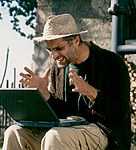 From Depression From Depression
to Hope
Tomáš Vorel's
Cesta z města
Ivana Košuličová
After Tomáš Vorel's last film, the self-indulgent Kamenný most (The Stone Bridge, 1996), his latest offering, Cesta z města (Out of the City, 2000), is an unexpected surprise that showcases the abilities of the director as never before. Moving on from his previous films—which include the postmodern Pražská pětka (Prague Five, 1988), the musical farce Kouř (The Smoke, 1990) and Kamenný most—Vorel uses personal testimony to analyze contemporary society, an approach which is used only rarely in Czech cinema.
Kamenný most's somber story of film director Tomáš trying to find his place in the world is more reminiscent of self-therapy than an artistic work created for audience. But while Cesta z města has evidence of being autobiographical, it does not stay wrapped up in itself, and it grows into an important and topical testimony.
Cesta z města opens with Tomáš Hanák playing the lead role of Honza. As a hardworking software programmer, Honza's life consists of a familiar hectic schedule complicated by ringing phones and traffic jams. A phone call from Honza's son, Honzík, interrupts his activities, and soon the two, along with the family dog Bingo, find themselves driving away for the weekend, with the consent of both Honza's ex-wife and his boss.
Out in the countryside, they stumble upon a beautiful young girl picking apples. She is Markéta and lives in a cottage with her grandmother, who is an herbal medicine woman. 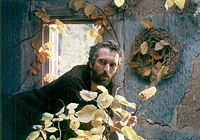 Markéta introduces Honza to the village life where he meets various characters such as Ludva the tractor driver, an evil hunter and a homosexual lumberjack. Under the influence of the natural and friendly atmosphere surrounding Markéta and her grandmother, Honza eventually decides to take an extended vacation from work. Markéta introduces Honza to the village life where he meets various characters such as Ludva the tractor driver, an evil hunter and a homosexual lumberjack. Under the influence of the natural and friendly atmosphere surrounding Markéta and her grandmother, Honza eventually decides to take an extended vacation from work.
Fortunately, Honza is able to work on the company project via his laptop and e-mail. He completes the project, but fails to notice that his son has accidentally deleted important company files while trying to play a video game.
Honza soon falls in love with Markéta and finds out that she has a finacé named Petr in the city. Markéta's grandmother dies and her funeral brings Markéta's parents as well as legal problems concerning grandmother's property and Markéta's future. By the time that Petr comes to fetch Markéta to bring her back to the university, she has already fallen in love with Honza and the two men fight it out over the girl.
Honza has only just won the battle and decided to settle down in the village with Markéta when a black 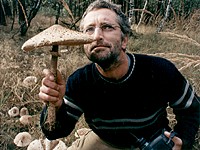 company car drives up to the cottage bringing the bad news that the company has lost millions due to Honzík's video-gaming. Honza must go back to the city to repair the damage or face criminal charges and Markéta, all alone now, decides to fulfill the wish of her family and continue her studies at the university. company car drives up to the cottage bringing the bad news that the company has lost millions due to Honzík's video-gaming. Honza must go back to the city to repair the damage or face criminal charges and Markéta, all alone now, decides to fulfill the wish of her family and continue her studies at the university.
It seems that the romance is forgotten, but the cold winter brings them all together again on a frozen pond with a few pairs of ice skates.
Reality and magic
Combining an ordinary reality with fictional magic is characteristic for Vorel. In Kamenný most, the director blends the two realities together subjectively in the mind of the main character. Cesta z města differs in that both realities stand opposite one another as two distinct principles.
The realistic world is represented by credibly depicted relations within a small village community. For example, we see the life and relationship of a married couple, Ludva and Vlastička (Boleslav Polívka and Eva Holubová).
The magic surrealistic world is represented by Markéta (Barbora Nimcová), who grows natural drugs in her grandmother's garden. Through her special herbs, she finds a connection with nature and 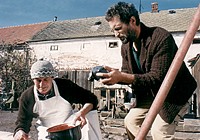 serenity that other people, including her Christian grandmother, find in church. serenity that other people, including her Christian grandmother, find in church.
Surreal visions are also personified through the figure of a ceramic dwarf. Dwarf motifs date back in Vorel's work to Pražská pětka and Cesta z města's dwarf made previous appearances in Kamenný most, where it appeared as a drawing, a ceramic figure and a 3D animation. These early uses of the dwarf are not fairy-tale figures of jollity and good nature, but dark, mysterious beings that represent both Vorel himself and his own nightmares. However, the dwarf in Cesta z města, a far more positive film, is more an ironic reference to the use of the personal testimony of the director.
Grandmother Jouzková (Ljuba Skořepová) is a healer who stands somewhere on the dividing line between fantasy and reality. While she is aware of the magic curative potency of various herbs, as a good Christian she is afraid of the illegal, hallucinogenic plants. She has the opportunity to experience the magic world of drugs, however, when she decides to set fire to a rich crop of her granddaughter's drugs and accidentally breathes in the smoke. As a result of this experience, she makes a connection between her Christian principles and pagan ones based on respect for nature and its demons.
City versus village
The entire story of Cesta z města is, as the title suggests, about the contrast between life in the village vs life in the city, with the director clearly preferring the former. To Vorel, the village is a place where nature is abundant, and there is time for love and the revival of dying relationships.
Contrasts between the village and the city are apparent not only in the 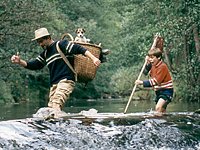 story of the main character, but also in the lives of other figures in the film. For example, Markéta joined her grandmother in the village after leaving her life in the city behind. Her old life consisted of her studies at the university and a potential teaching career, along with close family and friends. When her parents and Petr, her boyfriend, try to convince her to return to the city, Markéta only says that she prefers "to be nothing rather than something." story of the main character, but also in the lives of other figures in the film. For example, Markéta joined her grandmother in the village after leaving her life in the city behind. Her old life consisted of her studies at the university and a potential teaching career, along with close family and friends. When her parents and Petr, her boyfriend, try to convince her to return to the city, Markéta only says that she prefers "to be nothing rather than something."
The village, however, is far from perfect. The best example of this can be found in the character of Ludva. He is not only Honza's rival for Markéta's
love, but also represents a completely different perception of the world. While Honza talks about a future where no one will have to work anymore, and everyone will just play on computers, Ludva respects tradition and physical work and sees the computer as merely a technical toy. Ludva's character is one full of contradictions; on the one hand, he is a drunk who frequently beats his wife, and on the other he can be reflective and tender.
Vorel's stylization
The image of the world that Tomáš Vorel offers us in his new film relies on a grotesque stylization that might be difficult for some viewers to accept. Stylization is not the intention, in and of itself, but rather it offers a means of expressing a number of problems in today's society.
In this respect, Cesta z města is similar to the approach of director Věra Chytilová, particularly in her film Pasti, pasti, pastičky (Traps, 1998). Vorel was Chytilová's student at the FAMU film school in Prague and both directors have worked in experimental theater. (Despite the common ground between them, Kamenny most contains a figure that obviously represents Chytilová—and it is not a pleasant portrait). In addition, Tomáš Hanák was once married to Chytilová's daughter (actress and costume designer Tereza Kučerová), and he also took a starring role in Pasti, pasti, pastičky. For all this, though, Vorel maintains his originality as a film director and his work is quite definitely distinct from Chytilová's.
Calculated stylization is clearly visible from the acting of the majority of performers. The style of acting is close to caricature and 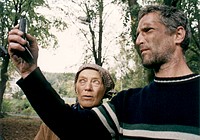 works with evident exaggeration and exercises in the grotesque: for example, Milan Šteindler's role of the evil hunter. Special poetic lyricism can be seen in Barbora Nimcová's role of Markéta, whose voice always has a musical quality. Ironic hyperbole and grotesque stylization can be seen in the role of Honza, as played by Tomáš. works with evident exaggeration and exercises in the grotesque: for example, Milan Šteindler's role of the evil hunter. Special poetic lyricism can be seen in Barbora Nimcová's role of Markéta, whose voice always has a musical quality. Ironic hyperbole and grotesque stylization can be seen in the role of Honza, as played by Tomáš.
Another notable effect of stylization is in the dialogue. Vorel often works with nonsense, stemming from his creation of the absurdist Sklep (Cellar) theater group. In Cesta z města, for example:
Honza: A ty jsi odkud? (So where are you from?)
Markéta: Jak se to vezme. (It depends how it is taken)
Honza: No a jak se to vezme? (And how is it taken?)
Markéta: No nějak se to vezme. (Well, it is taken somehow)
In both Vorel's work for Sklep and his films, dialogues are inter-cut by songs. Cesta z města is not a musical but a coherent story that is "exceptionalized" by a few songs presented by the untrained voices of the film's main performers. Each song has a different form, from sad lyricism (Markéta) to postmodern farce (the song about dwarfs sang by Honza and Honzík).
The director reaches a rigorously stylized effect in certain scenes where he sets two phenomena against each other that are not only completely opposite, 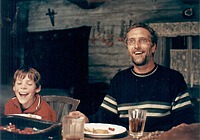 but their union is more than strange. Examples include scenes where Honza makes a call from his mobile phone during a fast-paced horse ride; when a carp swims alongside a mobile phone resting on the bottom of a pond; and when a man cannot move his arm away from his ear because of his mobile phone use. but their union is more than strange. Examples include scenes where Honza makes a call from his mobile phone during a fast-paced horse ride; when a carp swims alongside a mobile phone resting on the bottom of a pond; and when a man cannot move his arm away from his ear because of his mobile phone use.
The whole sequence of Markéta's grandmother's funeral is based on a clearly grotesque stylization. Both the pastor (Radomír Uhlíř) falling into the open grave and Markéta throwing a heavy bottle of liqueur at the casket are classical illustrations of a grotesque tableau. Another grotesque situation is the "fight" between Honza and Markéta's "town boyfriend" Petr. Petr, who is allergic to leaves, grass, cats and other things, is winning the fight until Honza catches a cat and puts it under Petr's nose. After kicking an inhaler out of Petr's hand, Honza becomes the winner.
Mixing the serious and the laughable is characteristic of Vorel's style, and he takes it to the point of artistry in Cesta z města. With the help of sharp 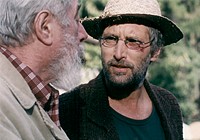 contrasts and grotesque situations, the director gives us a clear picture about each character and creates a waxwork of figures that provide a mock picture of the contemporary world.
contrasts and grotesque situations, the director gives us a clear picture about each character and creates a waxwork of figures that provide a mock picture of the contemporary world.
By concentrating on one small Czech border village, Vorel offers testimony to a world in which tradition and physical work are dying. Nature and the village stand in deep contrast to the world of virtual reality, computer games and software programs, and the film depicts a world which is trying to adopt one without losing the other. Cesta z města, in contrast to Vorel's previous film, offers a way out not only for the director but for society as a whole.
Ivana Košuličová, 26 February 2001
Also of interest:
Moving on:
|




 Markéta introduces Honza to the village life where he meets various characters such as Ludva the tractor driver, an evil hunter and a homosexual lumberjack. Under the influence of the natural and friendly atmosphere surrounding Markéta and her grandmother, Honza eventually decides to take an extended vacation from work.
Markéta introduces Honza to the village life where he meets various characters such as Ludva the tractor driver, an evil hunter and a homosexual lumberjack. Under the influence of the natural and friendly atmosphere surrounding Markéta and her grandmother, Honza eventually decides to take an extended vacation from work. company car drives up to the cottage bringing the bad news that the company has lost millions due to Honzík's video-gaming. Honza must go back to the city to repair the damage or face criminal charges and Markéta, all alone now, decides to fulfill the wish of her family and continue her studies at the university.
company car drives up to the cottage bringing the bad news that the company has lost millions due to Honzík's video-gaming. Honza must go back to the city to repair the damage or face criminal charges and Markéta, all alone now, decides to fulfill the wish of her family and continue her studies at the university. serenity that other people, including her Christian grandmother, find in church.
serenity that other people, including her Christian grandmother, find in church.  story of the main character, but also in the lives of other figures in the film. For example, Markéta joined her grandmother in the village after leaving her life in the city behind. Her old life consisted of her studies at the university and a potential teaching career, along with close family and friends. When her parents and Petr, her boyfriend, try to convince her to return to the city, Markéta only says that she prefers "to be nothing rather than something."
story of the main character, but also in the lives of other figures in the film. For example, Markéta joined her grandmother in the village after leaving her life in the city behind. Her old life consisted of her studies at the university and a potential teaching career, along with close family and friends. When her parents and Petr, her boyfriend, try to convince her to return to the city, Markéta only says that she prefers "to be nothing rather than something."
 works with evident exaggeration and exercises in the grotesque: for example, Milan Šteindler's role of the evil hunter. Special poetic lyricism can be seen in Barbora Nimcová's role of Markéta, whose voice always has a musical quality. Ironic hyperbole and grotesque stylization can be seen in the role of Honza, as played by Tomáš.
works with evident exaggeration and exercises in the grotesque: for example, Milan Šteindler's role of the evil hunter. Special poetic lyricism can be seen in Barbora Nimcová's role of Markéta, whose voice always has a musical quality. Ironic hyperbole and grotesque stylization can be seen in the role of Honza, as played by Tomáš. but their union is more than strange. Examples include scenes where Honza makes a call from his mobile phone during a fast-paced horse ride; when a carp swims alongside a mobile phone resting on the bottom of a pond; and when a man cannot move his arm away from his ear because of his mobile phone use.
but their union is more than strange. Examples include scenes where Honza makes a call from his mobile phone during a fast-paced horse ride; when a carp swims alongside a mobile phone resting on the bottom of a pond; and when a man cannot move his arm away from his ear because of his mobile phone use.  contrasts and grotesque situations, the director gives us a clear picture about each character and creates a waxwork of figures that provide a mock picture of the contemporary world.
contrasts and grotesque situations, the director gives us a clear picture about each character and creates a waxwork of figures that provide a mock picture of the contemporary world.